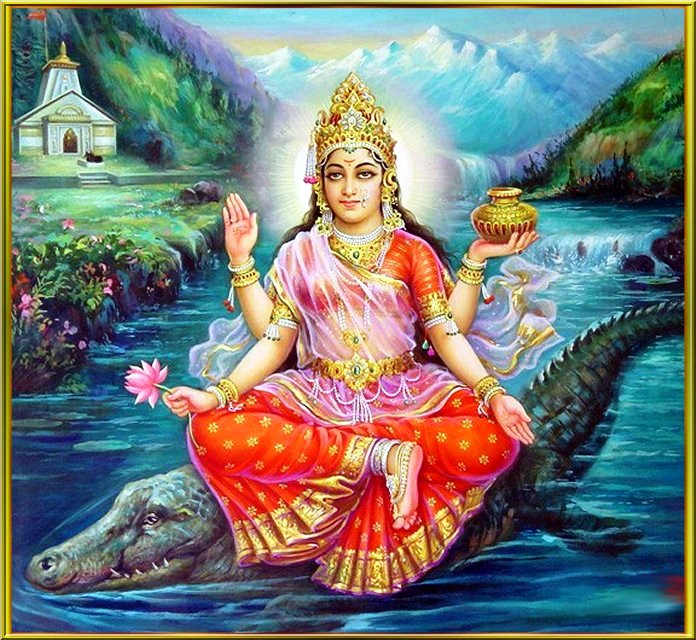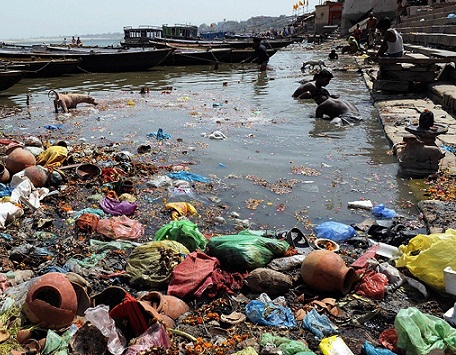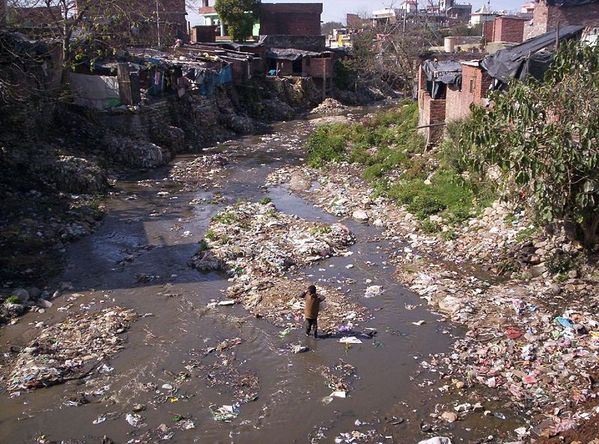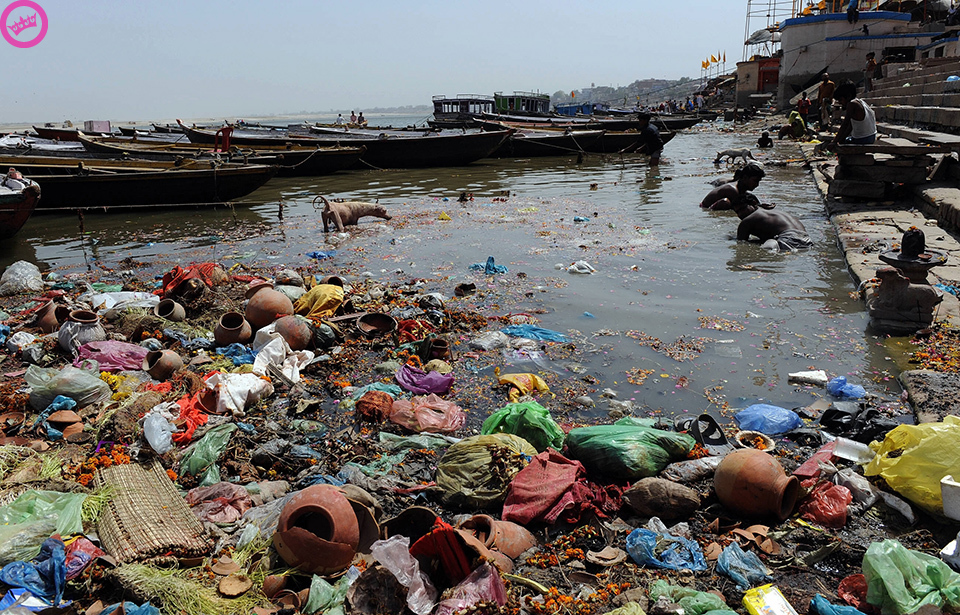 IN THE upper reaches of the Ganga, numerous hydel projects threaten the river’s ecosystem. And in the plains, as the river flows through the states of Uttarakhand, Uttar Pradesh, Bihar, Jharkhand and West Bengal, a toxic mix of untreated sewage, discarded garbage, agricultural run-off and industrial waste flow unabated into it. Hindus regard the Ganga water as pure; but in reality it is pure toxic muck! So much so that one of India’s most treasured resources was also crowned one of the world’s top five most polluted rivers in 2007.
IN THE upper reaches of the Ganga, numerous hydel projects threaten the river’s ecosystem. And in the plains, as the river flows through the states of Uttarakhand, Uttar Pradesh, Bihar, Jharkhand and West Bengal, a toxic mix of untreated sewage, discarded garbage, agricultural run-off and industrial waste flow unabated into it. Hindus regard the Ganga water as pure; but in reality it is pure toxic muck! So much so that one of India’s most treasured resources was also crowned one of the world’s top five most polluted rivers in 2007.
A Uttarakhand Environment Protection and Pollution Control Board (UEPPCB) study in 2011 slotted the Ganga water into four categories: A being fit for drinking, B for bathing, C for agriculture and D for excessive pollution. The presence of coliform bacteria in water is highly dangerous for human health, and in the Ganga waters, coliform levels are well above what is considered safe for farming, let alone bathing or drinking. While the level of coliform present in water should be below 50 mpn/100 ml for it to be declared fit for drinking, less than 500 mpn/100 ml for bathing and below 5,000 mpn/100 ml for agricultural use, the present level of coliform in the Ganga at Haridwar has reached 5,500 mpn/100 ml. According to the study, the main cause for high levels of coliform is the disposal of human faeces, urine and sewage directly into the river from its origin in Gaumukh till it reaches Haridwar.
Close to 89 million litres per day (mld) of sewage is released into the river from 12 municipal towns that fall along its route. During the Char Dham Yatra season, when nearly 15 lakh pilgrims visit the state, pollution levels increase even more. DD Basu, senior scientist, Central Pollution Control Board (CPCB), says: “Further downstream from Haridwar, the water is not fit for drinking, bathing or any other use.”
The river water turns toxic at Kanpur due to heavy influx of industrial waste and city sewage. The total sewage capacity of Kanpur is around 280 mld and the capacity to treat it is only 117 mld. Rakesh Jaiswal, an environmental activist, points out that the first common effluent treatment plant (CETP) commissioned in 1994 has a capacity to treat only 9 mld, whereas the tannery effluent discharge is 40 mld. Again, chrome liquor (a chemical used in tanning) that contains chromium, a known carcinogenic, also ends up untreated in the river. Though a common chrome treatment plant was installed in 2005, less than 900 litres are processed by the plant. “The reason being that many industrial units don’t send their waste water for treatment, whereas the plant can treat 70,000 litres daily,” says Jaiswal. In fact, on 1 October 2011, a two-judge Bench of the Allahabad High Court hearing a PIL on stopping pollution in the Ganga, directed that chromium-based tanneries in Kanpur be closed.
 Overall, there are 402 listed tanneries — besides many unlisted ones — in Kanpur. Of these, at least 100 use chromium-based systems to process leather. More than 80 percent of the waste water flows untreated and unchecked into the river. “In Kanpur, the responsibility to treat the waste water is shared between the government and industries, and that makes it easier for them to pass the buck. The government should only play the role of a regulator. Somebody who is polluting the Ganga should also clean it,” says Jaiswal.
Overall, there are 402 listed tanneries — besides many unlisted ones — in Kanpur. Of these, at least 100 use chromium-based systems to process leather. More than 80 percent of the waste water flows untreated and unchecked into the river. “In Kanpur, the responsibility to treat the waste water is shared between the government and industries, and that makes it easier for them to pass the buck. The government should only play the role of a regulator. Somebody who is polluting the Ganga should also clean it,” says Jaiswal.
ON THE banks of the Ganga in Varanasi, where millions of Hindus visit to pray, meditate, bathe and cremate their dead, the situation is no better. The holy town generates 350 mld of sewage, but the three sewage treatment plants (STPs) can treat only around 122 mld. Also, two of the three plants have not been functional for seven to eight years. The one that is operational is unable to function because of frequent power cuts. This means that close to 225 mld of sewage is released into the Ganga. The level of coliform is a few lakh mpn per 100 ml of water.
River Under Siege
Rs 1,100 Cr
Officially spent by the government of India to clean up the Ganga
Rs 20,000 Cr
Spent to clean up the river, According to the counsel for the Central Pollution Control Board
90-95%
Amount of water diverted for irrigation purposes, leading to low flow of the river and exacerbating pollution
2.9
Billions Litres Daily
Sewage discharged into the Ganga, according to government of India figures
 With the Ganga ferrying thousands of half-burnt corpses and animal carcasses, flesh-eating turtles were released to clean up the cesspool the river has become. But it didn’t work. According to BD Tripathi, member, National Ganga River Basin Authority (NGRBA), “A little more imagination was required. Here, turtles were released, but there was no effort to ensure that they survived. As a result, most of the turtles were poached by fishermen or killed.”
With the Ganga ferrying thousands of half-burnt corpses and animal carcasses, flesh-eating turtles were released to clean up the cesspool the river has become. But it didn’t work. According to BD Tripathi, member, National Ganga River Basin Authority (NGRBA), “A little more imagination was required. Here, turtles were released, but there was no effort to ensure that they survived. As a result, most of the turtles were poached by fishermen or killed.”
In Kolkata, the Ganga (also known as Hooghly) appears as dirty as anywhere else. “In 2005, the Calcutta High Court had asked us to look into the quality of water flowing into the river,” says Kalyan Rudra, adviser to the West Bengal government on environmental affairs. “Coliform levels were around 2 lakh mpn per 100 ml. The water is most polluted in Dakshineswar Ghat. In Kalighat, it has turned into a sewer channel. Factories rampantly discharge industrial waste into the river.”
Around 150 large industrial plants are lined up along the banks of the Hooghly around Kolkata. Together, these plants contribute 30 percent of the total industrial effluents reaching the Ganga. “As a result, the Gangetic river dolphin, which is the national aquatic animal, has almost become extinct. Even the Hilsa, Bengal’s favourite fish, is hardly found in the Hooghly anymore,” he laments.
Barrages built near Bhagalpur are also endangering the lives of the Gangetic dolphins. According to Sunil Chaudhary, an environmentalist rallying public action to save the Ganga: “We are working on dolphin conservation, and one cannot do it without saving the Ganga. Every being requires a minimum flow of the river to stay alive.”
In Bihar, the pollution in Ganga is acute near cities and places where industries have been set up. Apart from raw sewage and industrial waste, agricultural run-off is the single most important non-point or diffuse source of pollution, containing residues of chemical fertilisers, pesticides, insecticides and weedicides, which enter the river waters. Scientists and environmentalists complain that even today there is only a vague idea about the impact of agricultural run-off on river water quality and its ecology.
“Agricultural run-offs flow into the river with the monsoon rains,” says Ravi Chopra, director, People’s Science Institute, and former member of the NGRBA. “There has been no quantification and since the problem has not been studied, there is no solution.” Adds Sunil Chaudhary: “These pesticides and chemical fertilisers spread through the aquatic ecosystem and into the human food chain.”
However, what is most worrying is the low flow of the river during the lean season. NGRBA members and environmentalists have dubbed the reduced flow of the Ganga as “the biggest problem”. They feel since the scale of pollution also depends on the degree of dilution and velocity of the flow of water, it is necessary to maintain a minimum discharge in the river. In fact, the low flow of water during dry weather from Narora to Allahabad and Unnao in UP to Trighat in Bihar, makes these stretches the most polluted in the region. Also, with the intensity of irrigation in the Ganga basin being very high, scientists say that a large quantity of water is being diverted from the Bhimgoda barrage at Haridwar into the Upper Ganga Canal, to provide water for irrigation. At Bijnor, another barrage diverts the water into the Middle Ganga Canal. At Narora, there is further diversion of water into the Lower Ganga Canal. As a result, the Ganga does not receive water from any major tributary until the Ramganga joins it at Kannauj.
Flood irrigation is another issue that affects the waters of the Ganga. “The requirement of water for irrigation has not been calculated,” explains RK Sinha, member, NGRBA and HoD, environment sciences, Central University of Bihar.
“Our engineers are diverting water through canals and letting it flow through the crop field, leading to a loss of water. This water should have actually flowed into the river,” he adds. Sinha further clarifies: “I am not saying that water should not be diverted for irrigation; it should be, but then we should divert only the required quantity of water. For example, when the root of the wheat crop should be set one inch below ground level, then why do we need one foot of water?” Because of this diversion of the river water for irrigation and low flow, 70 percent of the Ganga between Narora and Allahabad is sewage. This stretch is also considered the most polluted stretch of the river.
 The absence of an organism called bacteriophages has further compounded the problem. “A major finding of the CPCB is that bacteriophages have disappeared from the Ganga waters. The presence of bacteriophages gives the river its anti-bacterial nature,” says DD Basu.
The absence of an organism called bacteriophages has further compounded the problem. “A major finding of the CPCB is that bacteriophages have disappeared from the Ganga waters. The presence of bacteriophages gives the river its anti-bacterial nature,” says DD Basu.
While a lot of importance is being given to the treatment of sewage water and industrial effluents, a CPCB report stresses on an assessment of flow and wastewater load. The report suggests that unabated discharge of treated sewage, even after 100 percent treatment, cannot bring the water to the level of bathing quality.
Vijay Panjwani, counsel for the CPCB for the past 17 years, talks of a scheme that has been adopted by many countries. “Wastewater should not be mixed with clean flowing river water,” he says. “It should be treated and then sent for agriculture or to industries. However much you may treat sewage water, it will never be clean.”
 Environmentalists say that so far, the government’s efforts to clean up the river have fallen woefully short. Twenty seven years and an investment of Rs 1,100 crore later, the Ganga Action Plan (GAP) that was supposed to improve the river’s health, has failed in its mission. In fact, the condition has only worsened.
Environmentalists say that so far, the government’s efforts to clean up the river have fallen woefully short. Twenty seven years and an investment of Rs 1,100 crore later, the Ganga Action Plan (GAP) that was supposed to improve the river’s health, has failed in its mission. In fact, the condition has only worsened.
Launched by then prime minister Rajiv Gandhi in 1985, GAP-Iwas supposed clean up the river in five years. With an official expenditure of Rs 452 crore, GAP-I was declared closed in March 2000. Simultaneously, in 1993, GAP Phase II was launched, covering 59 towns located along the river in the five states of Uttarakhand, UP, Jharkhand, Bihar and West Bengal. As many as 319 schemes were taken up under GAP-II, of which 200 were completed. GAP-II was later merged with the National River Conservation Authority (NRCP), with an aim to cover polluted stretches of 36 rivers in 20 states. GAP was one of India’s most ambitious river cleaning projects and it turned out to be a colossal failure. Panjwani disputes the official figure of 1,100 crore and claims that close to 20,000 crore has been spent on cleaning the Ganga. “The GAP failed to clean the Ganga, but it made some bureaucrats, contractors and politicians very rich,” he says.
A GOVERNMENT audit of the GAP for the period 1993-2000 says: “The GAP has met only 39 percent of its primary target of sewage treatment. There were heavy shortfalls in the achievement of the target set for creation of assets and facilities under the plan. Even the achievements made were poor indicators of the extent of the success of the GAP, as most of them had not functioned either fully or partially for varied reasons.” So where did the government go wrong?
 ‘KANPUR’S first common effluent treatment plant, commissioned in 1994, can treat only 9 mld, whereas the tannery effluent discharge is 40 mld. Again, chrome liquor that contains the carcinogenic chromium, also ends up untreated in the river’
‘KANPUR’S first common effluent treatment plant, commissioned in 1994, can treat only 9 mld, whereas the tannery effluent discharge is 40 mld. Again, chrome liquor that contains the carcinogenic chromium, also ends up untreated in the river’
Rakesh Jaiswal Environmental Activist
 ‘A LITTLE more imagination was required. Flesheating turtles were released in Varanasi, but there was no effort to ensure that they survived. As a result, most of the turtles were poached by fishermen or killed’
‘A LITTLE more imagination was required. Flesheating turtles were released in Varanasi, but there was no effort to ensure that they survived. As a result, most of the turtles were poached by fishermen or killed’
BD Tripathi Member, NGRBA
 ‘TODAY, you may not find the Gangetic dolphin, which is the national aquatic animal, in the river anymore. Even Bengal’s favourite fish, the Hilsa, is hardly found in the Hooghly’
‘TODAY, you may not find the Gangetic dolphin, which is the national aquatic animal, in the river anymore. Even Bengal’s favourite fish, the Hilsa, is hardly found in the Hooghly’
Kalyan Rudra Adviser to the West Bengal Government on Environmental Affairs
 ‘I AM not saying that water should not be diverted for irrigation, it should be, but then we should divert only the required quantity of water’
‘I AM not saying that water should not be diverted for irrigation, it should be, but then we should divert only the required quantity of water’
RK Sinha Member, NGRBA
 Experts believe that it is a classic case of official apathy and complete lack of vision and planning, which ensured that despite spending thousands of crores, the Ganga became more polluted. Calling the GAP a failure, Tripathi says that the government has frittered away crores of rupees on ill-designed and badly maintained wastewater treatment plants. “There was no proper planning,” he claims. “In 1998, when the matter came up in the Allahabad High Court, officers were asked if a quality analysis of the places where the STPs were installed, was done. The answer was a no.” Tripathi says the first phase of the GAP was implemented in a hurry due to political considerations.
Experts believe that it is a classic case of official apathy and complete lack of vision and planning, which ensured that despite spending thousands of crores, the Ganga became more polluted. Calling the GAP a failure, Tripathi says that the government has frittered away crores of rupees on ill-designed and badly maintained wastewater treatment plants. “There was no proper planning,” he claims. “In 1998, when the matter came up in the Allahabad High Court, officers were asked if a quality analysis of the places where the STPs were installed, was done. The answer was a no.” Tripathi says the first phase of the GAP was implemented in a hurry due to political considerations.
Sewage was identified as the root cause of all evil and STPs were set up at important places, as the officers thought that these STPs would clean the whole river. However, after the first survey, they were shocked to find out that the pollution had risen instead of going down. “The reason was because they failed to take the industrial waste into account,” says Tripathi. “There was absolutely no coordination between the Centre, state and local bodies.”
 Six months after setting up the STPs, there was no money to pay for electricity, maintenance and operations. “Funds were either less or not forthcoming,” says Panjwani. “Either the money was embezzled or diverted by state governments. Whatever the Centre sent was gobbled up by the states,” he adds.
Six months after setting up the STPs, there was no money to pay for electricity, maintenance and operations. “Funds were either less or not forthcoming,” says Panjwani. “Either the money was embezzled or diverted by state governments. Whatever the Centre sent was gobbled up by the states,” he adds.
Sunil Chaudhary believes that the governments’ approach is flawed and till they rectify it, no amount of money can save the river. “If Bihar or any state thinks that it can clean the Ganga, it’s mistaken,” he says. “All states from the upper Himalayas to those downstream have to participate. There has to be a national policy and then specific state policies. Most important, one needs local involvement of communities to save the river.”
Speaking on condition of anonymity, an NGRBA member says: “What is most surprising is that when you go for meetings, the first thing bureaucrats tell you is that they are ready with funds ranging from Rs 2,500 crore to Rs 3,000 crore. But they are clueless about the plan that will ensure that the money is spent judiciously.”
 Acharya Jeetendra of the Varanasi-based Ganga Mahasabha believes that nobody is serious about cleaning the Ganga. “It is diversion of funds in the name of Ganga,” he says. The seriousness of the government can be judged from the fact that even the River Conservation Authority, which oversees the plan and is headed by the PM, has not met since 1997.
Acharya Jeetendra of the Varanasi-based Ganga Mahasabha believes that nobody is serious about cleaning the Ganga. “It is diversion of funds in the name of Ganga,” he says. The seriousness of the government can be judged from the fact that even the River Conservation Authority, which oversees the plan and is headed by the PM, has not met since 1997.
IN 2008, the Ganga was declared a national river and in 2009, the NGRBA was formed under the chairmanship of PM Manmohan Singh. The NGRBA consists of 24 members with nine experts and 15 bureaucrats from relevant ministries. So far, the authority has met only thrice and the third meeting was held only after the renowned environmental engineer, Professor GD Agarwal, went on a fast unto death and three NGRBA members resigned. Notwithstanding its past failures, the Centre has embarked on yet another ambitious river cleaning programme, Mission Clean Ganga by 2020. The budget for this programme is Rs 15,000 crore. Besides, on 14 June 2011, the government also signed a $1 billion deal with the World Bank to save the river.
Will the government succeed this time in cleaning up the Ganga? As of now, the Ministry of Environment and Forests is unsure of meeting the 2020 deadline.
Brijesh Pandey is a Special Correspondent with Tehelka.
Also Read :































2 Comments